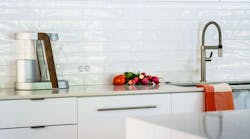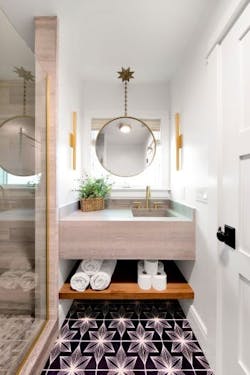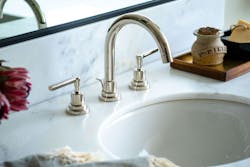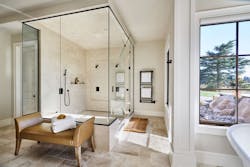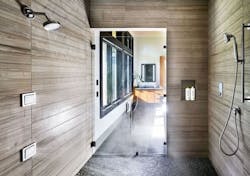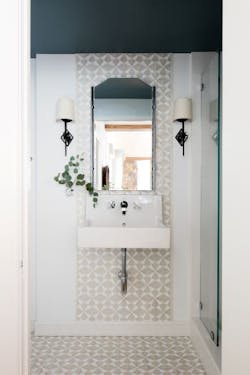From specifying plumbing for public restrooms, workplace kitchenettes or hospitality facilities, to designing kitchen and bath spaces in a private home, there are different considerations and requirements depending on how the space will be used.
Here are some basic guidelines to consider, no matter project size, to ensure long-term performance.
Know Your Audience and Preferences
“It is key to understand the preferences of the client as well as who will be using the fixture. Will adults or children be using the fixture?” says Garrison Hullinger, National Kitchen and Bath Association (NKBA) member and principal and lead designer at Garrison Hullinger Interior Design in Portland, OR.
“I also want to know if smart technology is desired. Would it be beneficial if the faucet was touch activated? It’s also important for me to understand the finishes and different offerings within the fixture type as I start specifying the plumbing.”
(Photo: Before starting a project, “it is key to understand the preferences of the client as well as who will be using the fixture,” says Garrison Hullinger, National Kitchen and Bath Association (NKBA) member and principal and lead designer at Garrison Hullinger Interior Design in Portland, OR. Credit: Shannon Ggem, Ggem Design Co)
Standard size sink and faucet dimensions are used throughout the plumbing industry. Most faucet manufacturers offer a wide selection of faucets in a variety of styles and placement configurations.
Faucets are typically set in either 4- or 8-inch width configurations. A centerset faucet features a spout and handles that are positioned on a deckplate, while a faucet with three separate sink holes for the spout and handles is known as a widespread faucet. There are also single-hole options, as well as wall-mounted, which requires a separate wall-mounted valve and drain for installation.
Behind the Wall
While not as glamorous, one of the most important steps that can be easily overlooked is determining what’s needed behind the wall to make your plumbing selections function properly. Making these decisions early can mean the difference to the success of a project.
“I specify plumbing with clients before the general contractor bidding process,” explains Shannon Ggem, NKBA member and principal and lead designer at Ggem Design Co in Los Angeles. “The plumber can order the valves needed immediately. Clients order the full plumbing list just days after, eliminating any rough plumbing delays and leaving plenty of time for finishes to be applied.”
Photo: In the last five years, the number of available finishes offered by decorative plumbing manufacturers has grown significantly; Credit: Blackstone Edge Studio.
This is why it’s important to have an established relationship with a plumbing contractor or showroom consultant to assist in writing the plumbing order. No one wants to realize after the wall is closed that a critical valve or special mechanism wasn’t ordered.
Finishing Touch
Once you’ve determined who is using the faucet and the type of faucet, it’s time to think about finishes. In the last five years, the number of available finishes offered by decorative plumbing manufacturers has grown significantly.
Finish options now run the gamut from chrome, brass and rose gold to polished, satin and matte. Polished chrome is the most widely available finish. It’s a cost-effective option and extremely durable finish, making it ideal for high-traffic settings even though the finish tends to show water spots and fingerprints.
[More from How to Specify series: Altro’s Integrated Floor and Wall Solutions Put People First]
When considering a finish other than polished chrome, like gold or matte black, check with the manufacturer to see if the finish is a living finish, which has no protective coating on it.. Living finishes will patina and continue to change over time, particularly in areas that are frequently touched, like on the handles.
Photo: From specifying plumbing for different spaces and uses, there are different considerations and requirements depending on how the space will be used; Credit: Blackstone Edge Studio.
“I always ask clients who do the cleaning to help in finish selection,” Ggem says. “I also find out their tolerance for patina.”
Finish names vary by manufacturer, so it’s best to view the finish in person or with a finish chip or sample. To ensure there aren’t any finish variations in a project, consider buying all of the fixtures and accessories from the same company. If time is a factor, consult with the manufacturer to confirm if the finish requires a longer lead time.
Know the Flow
Understand the flow rate of the fixtures you’re recommending, Hullinger encourages. “We all need to be doing our part for water conservation, even if it’s not mandated in your building code,” Hullinger says.
One way to achieve this is to specify products that carry the WaterSense label. WaterSense is a voluntary program from the EPA to encourage people to reduce water use. Faucets and faucet accessories (such as aerators) that carry the WaterSense label are certified to use at least 20% less water, save energy, and perform as well as or better than regular models.
Depending on where your project is located, a WaterSense faucet may not be enough. “I need to ensure California compliance for water savings,” Ggem notes.
CALGreen is California’s Green Building Standard, the country’s first mandatory green building standards code. There are standards for kitchen and bath faucets, showers, urinals and toilets. Public restroom faucets need to be below 0.5 gallons per minute and residential bathroom faucets can’t exceed a flow rate of 1.2 gallons per minute.
Cutting-Edge Restroom Technology Solutions
In the world of plumbing fixtures, smart technology is moving beyond motion sensor faucets and toilets to smart monitoring becoming increasingly important.
This is especially true in commercial settings where there is a high volume of traffic.
In 2019, the NKBA released the findings of its bath technology study (bit.ly/2HUElpy) which confirmed an increased interest in restroom tech solutions and products that maximize comfort, deliver efficiency, avoid problems and provide a feeling of safety.
(Photo: Standard size sink and faucet dimensions are used throughout the plumbing industry. Most faucet manufacturers offer a wide selection of faucets in a variety of styles and placement configurations; Credit: Shannon Ggem, Ggem Design Co.)
For the latest industry standards and codes, the NKBA offers kitchen and bath guidelines as part of its online Knowledge Base program. To learn more, visit NKBA.org.
About the Author: Dianne Pagoda is the senior manager, creative content for the National Kitchen & Bath Association (NKBA).
Experience other How to Specify topics:
